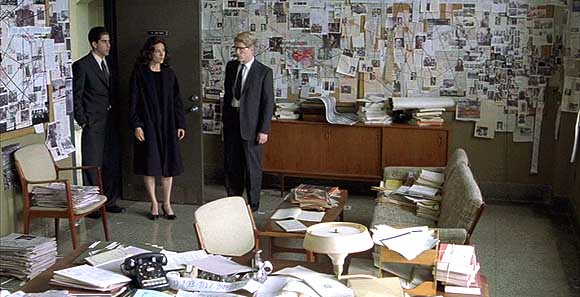Below: a couple more screen grabs from A Beautiful Mind, previously discussed here. Ronny Howard's art installation(s) are at once exotic, invoking the crazed outsider look of Thomas Hirschhorn's work, and familiar, amplifying the hoary Hollywood cliche of the "clipping filled shrine" from a hundred serial killer films. I wonder if anyone ever photographed the real John Nash's "codebreaking rooms" and if they looked anything like this? According to critic tedg (who took a class from Nash after the mathematician was first hospitalized), "Nash's madness was almost certainly caused by his 'breaking' his mind by straying too far from reality to get outside th[e] large problem he was working [on]. The conspiracies came not from cold war silliness but something far deeper: Phil Dick science fiction and Kabbalah. Not stupid numbers but topologies (forms). Not codes but manifold patterns in higher spaces. Literally extraterrestrial voices."

On the subject of extrinsic connections, you might recognize the male actors above as the "student newspaper nerds" from Richard Linklater's Dazed and Confused, a film about random but meaningful collisions (as was Linklater's Slacker), and of course the lovely, wholesome but somewhat cypherish Jennifer Connelly, who has served as the emotional constant in a topological maelstrom of quirky films. Quite a career she's had, from eclipsing Elizabeth McGovern as McGovern's younger self in Sergio Leone's Once Upon a Time In America, to sliding into a pool of maggots in Dario Argento's Phenomena, to besting Goblin King David Bowie in Labyrinth, to famously skinnydipping in Dennis Hopper's The Hot Spot, to wrecking Nick Nolte's marriage in Mulholland Falls, to recoiling from a mutant poodle in The Hulk, to doing heroin and a "double dildo dance" in Requiem for a Dream, to competing with Russell Crowe's imaginary friends in this film. What explains such a rich filmography? Is it just because she's "purdy"?
|
Below: a couple more screen grabs from A Beautiful Mind, previously discussed here. Ronny Howard's art installation(s) are at once exotic, invoking the crazed outsider look of Thomas Hirschhorn's work, and familiar, amplifying the hoary Hollywood cliche of the "clipping filled shrine" from a hundred serial killer films. I wonder if anyone ever photographed the real John Nash's "codebreaking rooms" and if they looked anything like this? According to critic tedg (who took a class from Nash after the mathematician was first hospitalized), "Nash's madness was almost certainly caused by his 'breaking' his mind by straying too far from reality to get outside th[e] large problem he was working [on]. The conspiracies came not from cold war silliness but something far deeper: Phil Dick science fiction and Kabbalah. Not stupid numbers but topologies (forms). Not codes but manifold patterns in higher spaces. Literally extraterrestrial voices."
On the subject of extrinsic connections, you might recognize the male actors above as the "student newspaper nerds" from Richard Linklater's Dazed and Confused, a film about random but meaningful collisions (as was Linklater's Slacker), and of course the lovely, wholesome but somewhat cypherish Jennifer Connelly, who has served as the emotional constant in a topological maelstrom of quirky films. Quite a career she's had, from eclipsing Elizabeth McGovern as McGovern's younger self in Sergio Leone's Once Upon a Time In America, to sliding into a pool of maggots in Dario Argento's Phenomena, to besting Goblin King David Bowie in Labyrinth, to famously skinnydipping in Dennis Hopper's The Hot Spot, to wrecking Nick Nolte's marriage in Mulholland Falls, to recoiling from a mutant poodle in The Hulk, to doing heroin and a "double dildo dance" in Requiem for a Dream, to competing with Russell Crowe's imaginary friends in this film. What explains such a rich filmography? Is it just because she's "purdy"?
- tom moody 5-20-2004 6:55 pm